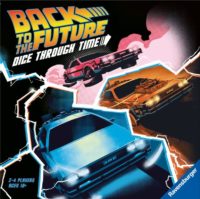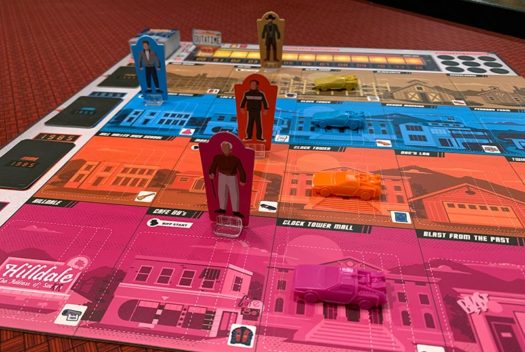Back to the Future: Dice Through Time game review

Last Wednesday was Marty McFly Day – October 21 – the day Marty McFly and Doc Brown traveled to the future (the 2015 future) in Back to the Future II.
You may not have even noticed. And that’s okay, because it means the space time continuum hasn’t been disrupted!
And even though we’re just now posting this game review, let’s do a bit of time travel of our own and pretend we’re back to a few days ago, October 21, taking a look at Back to the Future: Dice Through Time by Ravensburger.
How to play Back to the Future: Dice Through Time
The objective in Back to the Future: Dice Through Time is to find lost Items across time and get them back to their correct year and location. The number of Items to return depends on how much of a challenge the players like.
The game is played over a series of rounds where players draw Event cards, roll and use dice for actions, find and return Items, and advance the OUTATIME marker.

1. Event Cards
At the start of each round, the first player draws Event cards based on the number of players. For example, in a 4-player game, it will be 8 Event cards. They reveal each card one at a time and place them on the indicated locations on the board. If it’s a Special Event, those take place immediately.
If the card has a Biff icon in the upper right corner, the Biff standee for that year moves to the location.

2. Roll Dice
All players simultaneously roll their dice. If they’ve left any dice on the board from the last round, they may first choose to take those dice back in hand.

3. Perform Actions
Starting with the first player, players take turns using their rolled dice. Each player spends all their dice before moving on to the next player.
- Flux Capacitor: Move to the same location in any other year.
- Arrow: Move to a different location in the same year.
- Fist: Move Biff from your location to another location in the same year.
- Lightning: Reroll any unspent dice of your choice.
- Doc Brown: Remove any 2 Paradox tokens from the board.
- Wrench: Use as any one icon on an Event.
Any single dice may also be used to move to an adjacent location in the same year. Any two matching dice can be used as a Wild.

Dice are also used to fulfill Event cards. Each Event card on the board has icons in the upper-left corner. If a player’s DeLorean is on that location, and Biff is not there, the player may spend matching dice to remove that Event card. If there are more than 1 Event cards on a location, all must be completed at the same time to clear the location.
When cleared of Event cards, the player also removes any Paradox tokens at that location and draws an Item card from that year. They place it below their mat and must now get that Item back to its proper year and location.

To return an item, the player must be at that location and it must be clear of Events and Biff. The Item is placed face-up next to the board and the player moves the OUTATIME marker once space to the left and draws an Einstein token. The Einstein tokens are place face-up on the board for any player to use (spend) on their turns.
Players may also choose to leave one of their dice on a location. On a subsequent turn, any player on that location or in the same location in a future year may spend that die for its action. This is called Rippling Dice.
If a player’s DeLorean moves to a location with another DeLorean, the OUTATIME marker is moved to the right 2 spaces.

4. Advance OUTATIME
Once all players have taken their turns, players check to see which year has the most locations covered by Event cards. The OUTATIME marker is moved to the right by that number of locations (not number of events, but number of locations). If that year also has any Paradox tokens, the marker is moved additional spaces per Paradox token in that year.
5. Paradox Tokens
Every location with an Event card in the year that advanced the OUTATIME marker receives a Paradox token.
Players then pass the first player marker to the player to the left and a new round begins.

Game End
The game may end in two ways:
- Win = All lost Items have been returned to their proper year and location.
- Loss = The OUTATIME marker reaches the Game Over space on the track.
Can the whole family enjoy Back to the Future: Dice Through Time?
Back to the Future: Dice Through Time is clearly targeted at a family game audience. It’s cooperative, it has a recommended age of 10+, and the theme is all Back to the Future.
We’re big fans of cooperative family board games. And this game dishes out plenty of cooperation.
Every round begins with all players rolling their dice. So even before the first player of the round begins, players can discuss potential options of how players could use their dice to work together. For example, depending on the results of everyone’s rolls, it may make sense for one player to leave one of their dice on a location for a player taking a turn later to use.

And since crossing paths with another DeLorean has bad consequences, players also need to carefully coordinate their movements on their turns.
At the outset, you can choose your challenge level by how many Item cards you include in each year’s deck. And we love how the names of the levels tie to the theme. The levels are Science Experiment (just 2 Items per year), This is Heavy!, Great Scott!, and Nobody Calls Me Chicken! (all 5 Items per year).

We also like the element of luck in the game through the dice rolling and random Events. While the flow will be the same, how you have to work together changes from game to game because of what comes up. And we like those types of challenges – adjusting on the fly.
The Einstein tokens can be a fantastic help during the game too. So returning some Items as early in the game as you can is great because you’ll get Einstein tokens when you do. Since players won’t get to roll more dice throughout the game, those tokens are nice extra actions (or icons for resolving Events).

The Rippling Dice are also pretty cool. If you can’t get to a future year to use a die because you don’t have a Flux Capacitor result, you can leave that die on a location for someone else to use in later turns. It helps add to the puzzle-like nature of the game and is a perfect fit for the game theme.
Lastly, as with most cooperative board games, even though you have a main goal to accomplish, you can’t let bad things pile up too much or you’ll lose. And in this game that means not addressing the Events that keep popping up everywhere.
While you don’t need to clear them all to win, if you leave some for too long, Paradox tokens will send the OUTATIME marker cruising too quickly to the Game Over space. And nobody wants that to happen.

How do the Back to the Future games compare?
 If you’ve been following our game reviews, you may be wondering, “Didn’t they already review a Back to the Future cooperative board game?”
If you’ve been following our game reviews, you may be wondering, “Didn’t they already review a Back to the Future cooperative board game?”
You’re right!
In June, we reviewed Back to the Future: Back in Time by Funko. And now we’re covering Back to the Future: Dice Through Time by Ravensburger. Now that we’ve reviewed both, our next post will be a comparison of the two games.
If you could travel in time, you could already know the outcome. But for those who can’t travel in time, just wait patiently for a couple days and you’ll see our comparison.
We’d like to thank Ravensburger for a review copy of Back to the Future: Dice Through Time.





